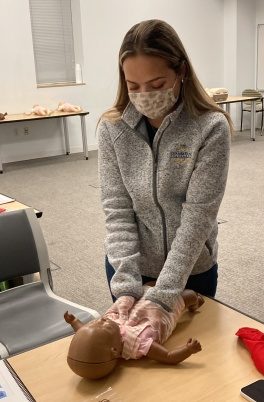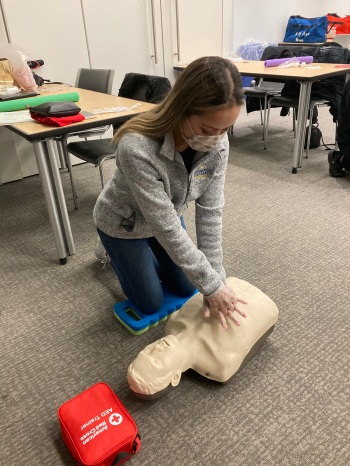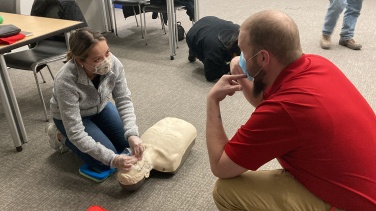Originally published on the American Red Cross of Illinois blog.

Many jobs require up-to-date lifesaving skills because they address health emergencies every day – people such as health care providers, first responders, and lifeguards. Others, including teachers and babysitters, are entrusted with precious young lives that could require aid at a moment’s notice.
Those of us who don’t face health emergencies every day can also benefit from Red Cross training. With a wide array of Lifeguarding, Caregiving, and Babysitting, and Swimming and Water Safety courses, the Red Cross can provide you with the training and skills you need to prevent, prepare for and respond to emergencies.
Why I Got Trained
COVID-19 has really changed the way many things are done with safety a top priority for many. This can mean limited social or in-person interactions. Thankfully, the Red Cross has done a great job of creating different formats for their training programs to better suit everyone’s needs and desires. Updated virtual and blended classes are offered, meaning you can be certified in First Aid, CPR, AED use, babysitting, and even some aspects of water safety are now offered completely online. In-person courses and blended classes, meaning partially online and an abbreviated in-person portion, are also offered.
It was important to be trained in CPR & First Aid because, at any given time, there could be an individual who becomes unconscious or facing a life-threatening injury that could need help. Knowing what to do and not feeling like a helpless bystander at that moment can be rewarding. The hope is that you will never have to use your training in real life, but if it were to happen, it’s important that you’re trained and ready. So I decided to get ready.
My Training Experience

I chose to do a blended course to get certified in Adult and Pediatric First Aid/CPR/AED so I could really get a feel as to how the classes are run and how they were able to modify a portion of the learning to be online. To my surprise, the online portion was very informative. They included images and videos to help you truly understand how to perform CPR on an adult and infant, and give you scenarios of a real-life emergency so you can see how everything is done. I am now well versed in the “Check, Call, Care” mantra. They also had quizzes to ensure you are retaining the information and understanding it to the fullest. Having the training program be split between online and in-person shortened the course as well. Instead of having to go to a class that could last up to 6 hours, the class I attended was only one and a half hours. Also, the online portion is done on your own at your own pace and would probably take you around 2 hours to complete.

Joe, the instructor of the class, was highly adept at keeping the class informative and fun. He made sure to help everyone individually if they needed assistance with CPR compressions, he was there if we had any questions, and so much more. Not only was he of great aid, the CPR manikins that we practiced on were also very helpful. When practicing chest compressions, red lights would illuminate inside the manikin as a guide to know if your compressions were firm and fast enough. The goal was to always have its forehead light up for the duration of the CPR. That would ensure that we had a steady rhythm and were also going deep enough on each compression. Everything needed for the training course was provided. We did not need to bring anything other than ourselves. We also had the opportunity to help each other out. I was partnered up with two other individuals from the class and we would take turns on the manikins, while also following the guidebook to make sure our CPR techniques were correct.
The Red Cross also ensures that we’re all still following CDC guidelines when it comes to COVID including wearing face masks and spacing us out in the room. When learning what to do when someone is choking, the class has been altered to be contact-less and we practiced pelvic thrusts and back blows with chairs representing the victim or on ourselves. These changes, though minor, made the class feel safe while still learning all the needed information. Upon successful completion, a 2-year digital certificate is issued to all students.
Get Trained Today
I would recommend a blended course to anyone looking for training who also wants to minimize their in-person interactions. Being trained in what to do in an emergency can help you feel empowered to help save a life.
To learn more about available Red Cross training courses near you and online, visit redcross.org/TakeAClass.
